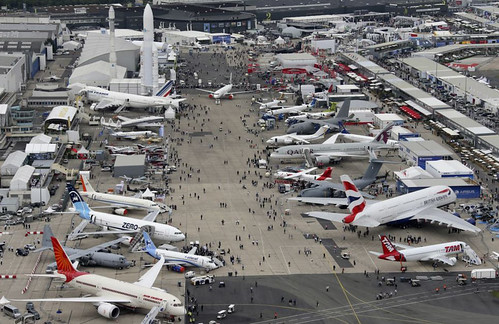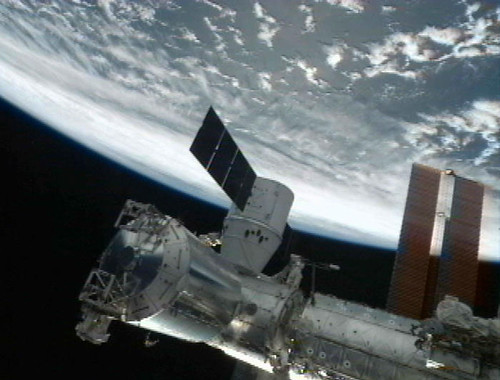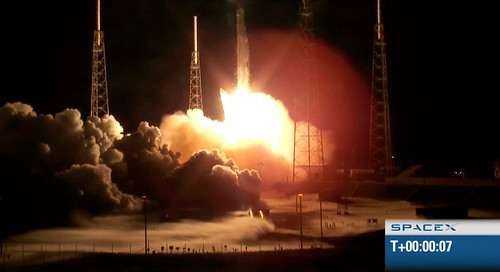Patience, Grasshopper
Monday, October 14th, 2013Awesome: another Grasshopper test filmed by a RC hexacopter, this time to 744 meters in altitude.
Awesome: another Grasshopper test filmed by a RC hexacopter, this time to 744 meters in altitude.
Awesome footage from SpaceX…
On June 14, SpaceX’s Grasshopper flew 325 m (1066 feet)–higher than Manhattan’s Chrysler Building–before smoothly landing back on the pad. For the first time in this test, Grasshopper made use of its full navigation sensor suite with the F9-R closed loop control flight algorithms to accomplish a precision landing. Most rockets are equipped with sensors to determine position, but these sensors are generally not accurate enough to accomplish the type of precision landing necessary with Grasshopper. Previous Grasshopper tests relied on the other rocket sensors but for this test, an additional, higher accuracy sensor was in the control loop. In other words, SpaceX was directly controlling the vehicle based on new sensor readings, adding a new level of accuracy in sensing the distance between Grasshopper and the ground, enabling a more precise landing. Grasshopper is a 10-story Vertical Takeoff Vertical Landing (VTVL) vehicle designed to test the technologies needed to return a rocket back to Earth intact. While most rockets are designed to burn up on atmosphere reentry, SpaceX rockets are being designed not only to withstand reentry, but also to return to the launch pad for a vertical landing. The Grasshopper VTVL vehicle represents a critical step towards this goal. Grasshopper consists of a Falcon 9 rocket first stage tank, Merlin 1D engine, four steel and aluminum landing legs with hydraulic dampers, and a steel support structure.

Naturally, Arianespace participates in the Paris Air Show and the swirling questions are related to a competitor who isn’t there: SpaceX. Their response is predictable and defensive, and with a billion euros at stake, can you blame them?
There’s a real need for commercial launch services and well-run commercial satellite operators want to make sure there’s viable set of competitors out there. Spreading business around to Sea-Launch, Arianespace and ILS (Proton) helps keep them in business and assures the operators a way into space when needed. Commercial launches from Cape Canaveral were always preferred — both for location and reliability. The cost, however, made the bean-counters squirm.
Reading the Reuters report by Irene Klotz about how there were no commercial launches struck me as naive. The U.S. Air Force reserved all the available launch vehicle manifests for Atlas and Delta in the U.S. for their payloads — not because of competition from foreign-based companies. Yes, there’s the cost factor. If you could save $20 million on a single launch by going to Kazakhstan or French Guiana, why not?
And that’s why SpaceX is set to grab a bunch of business by launching from the Cape at a lower cost. If you factor in the prospect of all-electric spacecraft, then you could see a seismic shift in the market dynamics of launch services. So you shouldn’t wonder why Arianespace is being defensive, as cited by Space News…
One of the Falcon 9’s most potent arguments is that it is capable of carrying two all-electric-propulsion satellites at a time into geostationary transfer orbit. But according to the first customer of Boeing Space and Intelligence Systems’ all-electric 702SP platform, Satmex of Mexico, it will take the Satmex satellite about eight months to reach its final orbital position and begin generating revenue.
Factoring in a longer orbit-raising into the overall spacecraft replacement cycle is certainly possible. Now, if only satellite operators start passing along these savings from simplified spacecraft design, lower-cost launch and cost-effective propulsion systems to lowering the cost of leasing bandwidth to customers remains to be seen.

SpaceX got the job done: the Dragon capsule has docked with the International Space Station!
Check out their B-roll video….
SpaceX B-Roll Package for Broadcast from SpaceX on Vimeo.
Actually, they opened the hatch early because they had the munchies (hat-tip to SpaceFlightNow.com).
“Looks like we’ve tamed the Dragon,” radioed space station commander Suni Williams. “We’re happy she’s on-board with us. Thanks to everyone at SpaceX and NASA for bringing her here to us, and the ice cream.”
Judging by their launch manifest, I’d say these SpaceX folks are for real and will be around for many years.
Nice video by Bad Astronomer…
One of the nine Merlin engines powering the Falcon 9 had a failure 90 seconds into the flight. It’s not clear what happened just yet, but there is pretty dramatic footage of the engine failure; in the slow motion video below you can see some sort of flash and puff of flame at the 30 second mark (I’ve set the video to start 22 seconds in).
You can see a bright spot glowing on the upper right engine, then what looks like shrapnel blowing back as well, so it appears something catastrophic happened to the engine.
The launch itself was pretty cool…

Great moment in space business: the launch of the Falcon-9 from the Cape. Their press release lead tells it like it is:
Today, Space Exploration Technologies (SpaceX) successfully launched its Falcon 9 rocket carrying a Dragon spacecraft to orbit in an exciting start to the mission that will make SpaceX the first commercial company in history to attempt to send a spacecraft to the International Space Station — something only a handful of governments have ever accomplished.
At 3:44 a.m. Eastern, the Falcon 9 carrying Dragon launched from SpaceX’s launch pad at the Cape Canaveral Air Force Station. Now Dragon heads toward the International Space Station. On that journey it will be subjected to a series of tests to determine if the vehicle is ready to berth with the station.
Watch the launch videos…
We’re hoping the mission keeps on succeeding!
Awesome: Falcon 9 Heavy, announced yesterday, is after the ULA business…
The Falcon Heavy could put 117,000 pounds into the same orbit as the International Space Station. The space shuttle hauls about 54,000 pounds into orbit. The old Saturn V could carry more than 400,000 pounds of cargo.
The old Soviet Union had a giant moon rocket bigger than the Falcon Heavy, but it failed in all four launch attempts. Another Soviet rocket, also bigger than Falcon Heavy and designed to launch its version of the space shuttle, had one successful flight more than 20 years ago.
While the new Space X rocket is designed initially for cargo, it satisfies NASA’s current safety requirements for carrying humans and after several launches could carry people too, Musk said. He has said that if NASA does buy rides on commercial rockets, he would be able to fly astronauts to the space station in his smaller Falcon 9 rocket and Dragon capsule within three years.
Potential customers for the new larger rocket are NASA, the military, other governments and satellite makers.Musk said Falcon Heavy will be far cheaper than government or private rockets. Launches are about $100 million each. He said the Air Force pays two older more established aerospace firms about $435 million for each of its launches. Over its 40 year design history, the space shuttle program has cost about $1.5 billion per launch, according to a study by the University of Colorado and an Associated Press analysis of NASA budgets.
Musk, who has a contract to supply the space station with cargo using the smaller Falcon 9, said his pricing is more fixed than traditional aerospace firms. He joked: “We believe in everyday low prices.”
To get costs that low, Musk said he needs to launch about four Falcon Heavy rockets a year but plans on launching about 10. He doesn’t have a paying customer for his first launch, but is in negotiations with NASA and other customers for flights after his company proves the new rocket flies.
“It would be great if it works, if it’s safe,” said Henry Lambright, a professor of public policy and space scholar at Syracuse University. “I don’t want to come across as skeptical, but I am.”
Lambright said companies have often made big claims about private space without doing much. But, he added, Musk has some credibility because of his successful Falcon 9.If Musk’s plans work, it will give President Barack Obama’s space policy a needed boost, Lambright said. Obama has been battling some in Congress over his plans to use more private space companies, like Space X, for getting people to orbit with NASA concentrating on missions to send astronauts to new places, such as nearby asteroids.
Several companies are vying to launch private rockets that could replace the shuttle. NASA is now paying Russia to send astronauts to and from the space station on Soyuz spacecraft.
Howard McCurdy, a space policy expert at American University, said of Musk: “If he’s not in the lead, he’s well positioned for the finish.”McCurdy said NASA’s space shuttle was a technological marvel, but had a bad business model and wasn’t cost effective. He said Musk, who is using his own money in his privately held firm, has incentive to be more financially savvy.